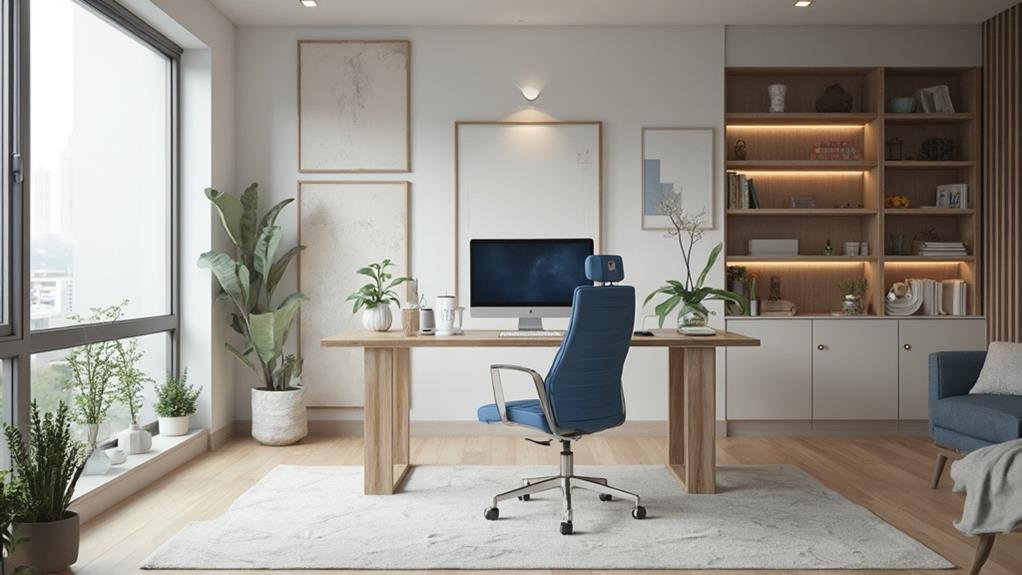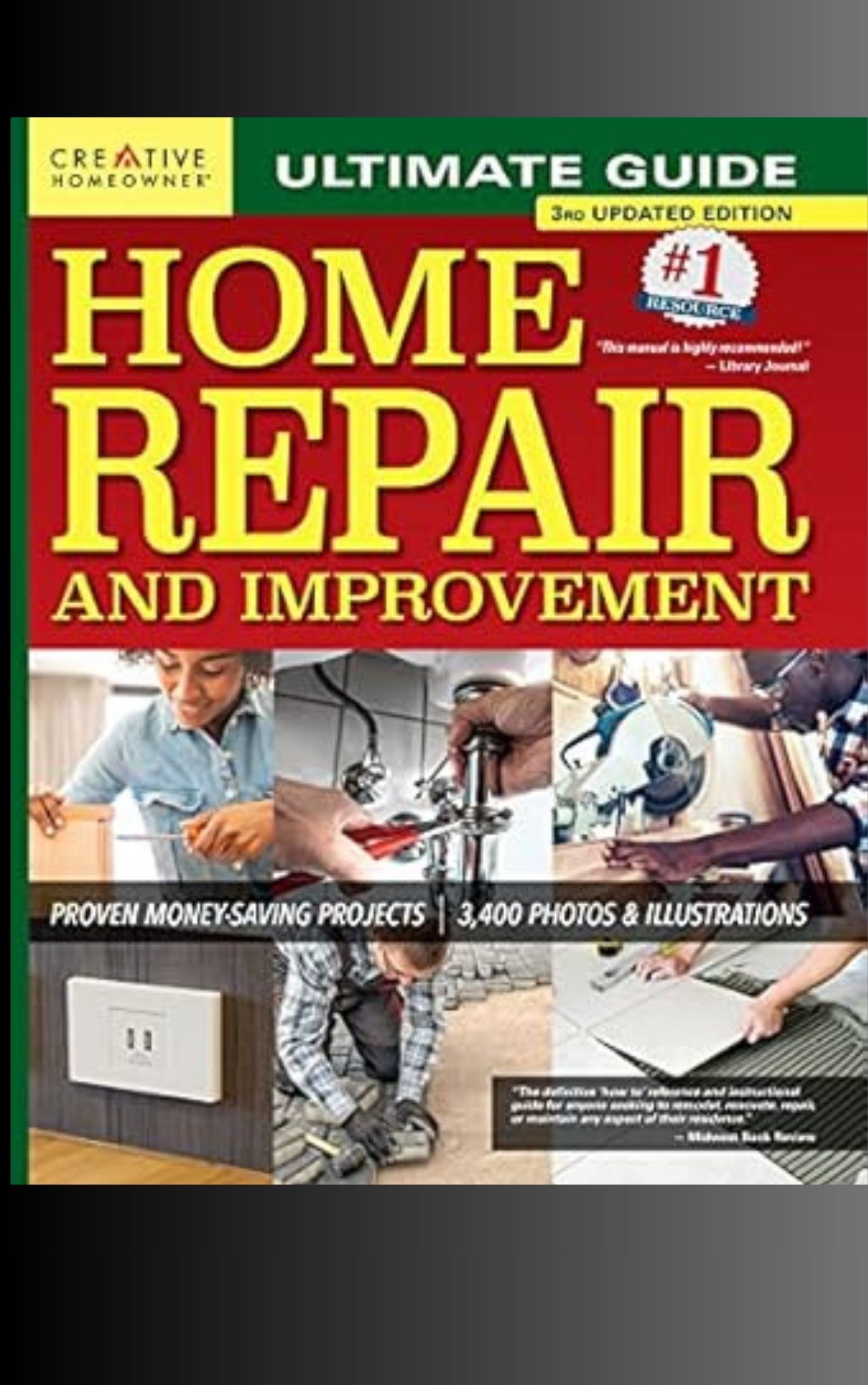The remote work era has sparked a revolution in home office renovations. Hot trends include multifunctional furniture solutions, smart storage systems, and ergonomic workspace designs. Homeowners are optimizing natural light, implementing soundproofing techniques, and incorporating biophilic elements for a more productive environment. Technology integration is crucial, with built-in charging stations and cable management becoming standard features. Color psychology plays a role in creating focus and energy. Meanwhile, outdated trends like cramped corner desks and insufficient lighting are being phased out. These innovative approaches are transforming spare rooms and unused spaces into efficient, comfortable workspaces. Discover how these trends can elevate your home office experience.
Multifunctional Furniture Solutions
When creating a home office, multifunctional furniture solutions are essential for maximizing space and productivity. These versatile pieces serve multiple purposes, allowing you to make the most of limited square footage while maintaining a functional workspace. Consider investing in a desk with built-in storage compartments or a fold-down table that can be tucked away when not in use. Wall-mounted shelving units with integrated desk surfaces offer vertical storage options and create a compact workstation.
Ottomans with hidden storage provide extra seating for clients or colleagues while doubling as filing cabinets. Convertible furniture, such as a murphy bed with a desk attachment, allows guest rooms to transform into office spaces effortlessly. Modular shelving systems offer customizable storage solutions that can be reconfigured as your needs change. Look for chairs that can adjust for both office work and relaxation, featuring ergonomic designs and multiple reclining positions. By incorporating these multifunctional furniture solutions, you can create a flexible and efficient home office that adapts to your changing work requirements while maintaining a cohesive and organized space.
Smart Storage Systems
Smart storage systems are revolutionizing home office organization, allowing for efficient use of space and improved productivity. These innovative solutions incorporate technology and clever design to maximize storage capacity while maintaining a sleek, clutter-free appearance.
Wall-mounted shelving units with adjustable components offer customizable storage options that can adapt to changing needs. Modular systems allow for easy reconfiguration as workspace requirements evolve. Built-in cabinetry with hidden compartments and pull-out drawers provide ample storage while maintaining a clean aesthetic.
Smart storage furniture, such as desks with integrated charging stations and cable management systems, help reduce visual clutter and improve workflow. Vertical storage solutions, including floor-to-ceiling bookcases and hanging organizers, make use of often-overlooked wall space.
Digital storage solutions, such as cloud-based systems and networked attached storage (NAS) devices, complement physical storage by reducing the need for paper files and bulky hardware. Smart lockers with biometric access control offer secure storage for sensitive documents and valuable equipment.
Ergonomic Workspace Design
Ergonomic workspace design has become a crucial aspect of creating efficient and comfortable home offices. This approach focuses on optimizing the work environment to reduce physical strain and enhance productivity.
Key elements include adjustable chairs with proper lumbar support, height-adjustable desks that allow for both sitting and standing positions, and correctly positioned monitors to maintain proper eye level and reduce neck strain.
Lighting plays a vital role in ergonomic design, with a combination of natural and artificial light sources to reduce eye fatigue. Task lighting should be adjustable and positioned to minimize glare on screens.
Proper keyboard and mouse placement is essential to prevent repetitive strain injuries, with wrist rests and ergonomic peripherals offering additional support. Cable management systems keep wires organized and out of the way, reducing tripping hazards and creating a cleaner workspace.
Footrests and anti-fatigue mats can provide comfort for those who stand for extended periods. Incorporating plants and using calming colors can contribute to a more relaxed and focused work environment.
Natural Light Optimization
Natural light's importance in home office design cannot be overstated. It not only enhances productivity and mood but also reduces eye strain and energy costs. To optimize natural light, consider positioning your desk near a window, ensuring it faces perpendicular to the light source to minimize glare. If possible, install larger windows or skylights to increase the influx of daylight.
For spaces with limited natural light, use reflective surfaces like mirrors or light-colored walls to bounce light around the room. Alternatively, invest in full-spectrum light bulbs that mimic natural daylight. Window treatments play a crucial role in light control; opt for adjustable blinds or sheer curtains that allow you to modulate light throughout the day.
If your home office lacks windows, consider a glass door or interior windows to borrow light from adjacent rooms. Light tubes or solar tubes can also be installed to channel natural light from the roof into windowless spaces. Remember, the goal is to create a well-lit environment that supports focus and well-being without causing discomfort or excessive heat. Balancing natural light with task lighting ensures optimal illumination for various work activities throughout the day.
Soundproofing Techniques
Effective soundproofing is crucial for maintaining concentration and privacy in a home office. Several techniques can significantly reduce noise intrusion and create a more productive workspace.
One popular method is installing acoustic panels on walls and ceilings to absorb sound waves. These panels come in various designs and can be customized to match the room's decor.
Another effective approach is using weatherstripping and door sweeps to seal gaps around doors, preventing sound from leaking in or out. For windows, consider installing double-pane or laminated glass, which provides better sound insulation than standard single-pane windows. Alternatively, soundproof curtains can offer a more cost-effective solution.
Flooring plays a significant role in sound transmission. Adding a layer of mass-loaded vinyl under carpets or using cork or rubber underlayment beneath hardwood floors can dramatically reduce noise transfer. For existing hardwood floors, area rugs can help absorb sound.
Lastly, addressing air gaps and electrical outlets is essential. Use acoustic caulk to seal any cracks or gaps in walls, and install specially designed outlet covers to minimize sound transmission through these often-overlooked areas.
Biophilic Design Elements
While soundproofing focuses on creating a quiet environment, incorporating biophilic design elements brings nature into the workspace, promoting well-being and productivity. Biophilic design integrates natural materials, patterns, and living elements into the built environment, fostering a connection with nature.
To incorporate biophilic elements into your home office, consider adding indoor plants such as succulents, ferns, or peace lilies. These not only improve air quality but also provide a visual connection to nature. Natural materials like wood, stone, or bamboo can be used for furniture, flooring, or accent pieces.
Maximize natural light by positioning your desk near a window and using sheer curtains to filter sunlight. Integrate nature-inspired patterns and textures through wallpaper, artwork, or textiles featuring botanical prints or organic shapes. Water features, such as small desktop fountains, can introduce soothing sounds and movement.
Consider using earth-toned color palettes to create a calming atmosphere. Finally, incorporate natural scents through essential oils or candles with fragrances like lavender or pine to further enhance the sensory experience of nature in your home office.
Technology Integration
Seamlessly integrating technology into a home office is crucial for maximizing productivity and efficiency. Modern home offices require a robust technological infrastructure to support various devices and connectivity needs.
Start by installing high-speed internet and a reliable Wi-Fi network to ensure uninterrupted online access. Consider adding multiple Ethernet ports for direct connections to improve stability for video conferencing and data-intensive tasks.
Invest in a smart power strip or surge protector to manage multiple devices and protect equipment from power surges. Implement a wireless charging pad or built-in USB ports to keep mobile devices powered without cluttering the workspace.
For video calls, incorporate proper lighting solutions, such as ring lights or adjustable LED panels, to enhance visibility and professionalism.
Explore smart home technology to automate routine tasks, such as voice-activated assistants for scheduling and reminders, or smart thermostats for optimal temperature control. Consider a cloud-based storage system for seamless file access across devices and locations.
Color Psychology in Offices
Color choices in a home office significantly impact mood, productivity, and overall well-being. Understanding color psychology can help create an optimal work environment tailored to individual needs and preferences.
Blue, often associated with calmness and focus, is an excellent choice for enhancing concentration and efficiency. Green, reminiscent of nature, can reduce eye strain and promote a sense of balance and harmony. Yellow, in moderation, can stimulate creativity and optimism, while orange may boost enthusiasm and energy levels.
For those seeking a professional ambiance, neutral tones like gray or beige provide a sophisticated backdrop. However, it's crucial to avoid an overly sterile environment by incorporating pops of color through accessories or accent walls. Red, known for its intensity, should be used sparingly as it can increase heart rate and potentially lead to stress. Purple, associated with luxury and creativity, works well in artistic or design-oriented spaces.
When selecting colors, consider the room's natural light and size, as darker hues can make small spaces feel cramped. Ultimately, the ideal color scheme should align with personal taste and work requirements to create a productive and inspiring home office.
Outdated Home Office Trends
Trends in home office design evolve rapidly, leaving some once-popular elements feeling outdated. One such trend is the use of bulky, oversized desks that dominate the space. These have been replaced by sleek, minimalist workstations that prioritize functionality and space efficiency. Similarly, heavy, dark wood furniture is giving way to lighter, more versatile materials like glass and metal.
The era of beige walls and matching office furniture sets is also coming to an end. Modern home offices embrace bold colors, mixed textures, and eclectic design elements that reflect personal style. Outdated storage solutions like large filing cabinets are being phased out in favor of digital storage and compact, multi-functional pieces.
Formal, rigid office layouts are no longer favored, with flexible, adaptable spaces becoming the norm. Static lighting fixtures are being replaced by layered lighting options that can be adjusted for different tasks and times of day. Finally, the trend of hiding technology behind cabinets or in designated computer armoires has become obsolete, as sleek, integrated tech solutions take center stage in contemporary home office design.
Frequently Asked Questions
How Much Does a Typical Home Office Renovation Cost?
The cost of a typical home office renovation varies widely, ranging from $5,000 to $30,000. Factors influencing the price include room size, structural changes, materials, furniture, technology upgrades, and labor costs. DIY options can reduce expenses significantly.
Can I Claim My Home Office Renovation Expenses on My Taxes?
Claiming home office renovation expenses can be complicated. Consult a certified tax professional for precise guidance. Generally, if you use the space exclusively for work, you may deduct a portion of renovation costs as a business expense.
What Permits Are Required for Home Office Renovations?
Permits required for home office renovations vary by location and scope of work. Typically, electrical, plumbing, or structural changes require permits. Check with your local building department for specific requirements before starting any renovation project.
How Long Does a Complete Home Office Renovation Usually Take?
A complete home office renovation typically takes 2-6 weeks, depending on the scope of work. Factors influencing timeline include structural changes, electrical upgrades, custom cabinetry, flooring installation, and any required permitting processes. Proper planning can streamline the project.
Are There Eco-Friendly Options for Home Office Renovations?
Yes, there are numerous eco-friendly options for home office renovations. These include using sustainable materials like bamboo or reclaimed wood, installing energy-efficient lighting and appliances, choosing low-VOC paints, and incorporating natural light and ventilation to reduce energy consumption.
Conclusion
The evolution of home office design reflects the changing nature of work in the digital age. By incorporating multifunctional furniture, smart storage, ergonomic layouts, and biophilic elements, homeowners can create productive and inspiring workspaces. A case study of a Silicon Valley startup founder who transformed her garage into a high-tech home office demonstrates the potential for innovative design to enhance productivity and work-life balance. As remote work continues to grow, these trends will likely shape the future of residential architecture and interior design.

